Both liberal and conservative political elites in the New York–Washington corridor of power have been on top of the world for so long that they can’t remember how they got there, writes Alfred McCoy.
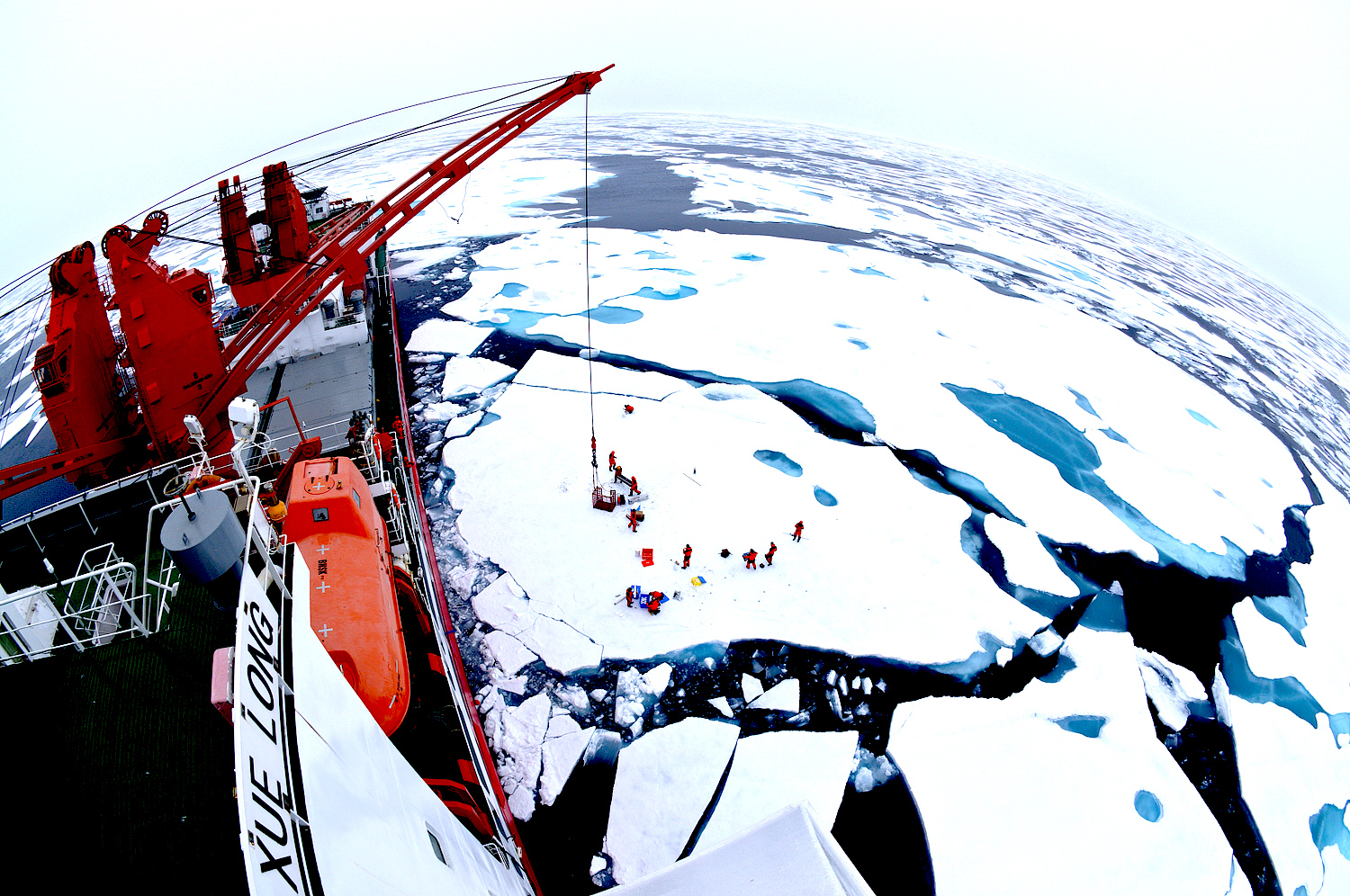
Drift ice camp in the middle of the Arctic Ocean as seen from the deck of icebreaker Xue Long, 2010. (Timo Palo, CC BY-SA 3.0, Wikimedia Commons)
By Alfred McCoy
TomDispatch.com
 Throughout 2021, Americans were absorbed in arguments over mask mandates, school closings and the meaning of the Jan. 6 attack on the Capitol. Meanwhile, geopolitical hot spots were erupting across Eurasia, forming a veritable ring of fire around that vast land mass.
Throughout 2021, Americans were absorbed in arguments over mask mandates, school closings and the meaning of the Jan. 6 attack on the Capitol. Meanwhile, geopolitical hot spots were erupting across Eurasia, forming a veritable ring of fire around that vast land mass.
Let’s circle that continent to visit just a few of those flashpoints, each one suffused with significance for the future of U.S. global power.
On the border with Ukraine, 100,000 Russian troops were massing with tanks and rocket launchers, ready for a possible invasion. Meanwhile, Beijing signed a $400 billion agreement with Tehran to swap infrastructure-building for Iranian oil. Such an exchange might help make that country the future rail hub of Central Asia, while projecting China’s military power into the Persian Gulf. Just across the Iranian border in Afghanistan, Taliban guerrillas swept into Kabul ending a 20-year American occupation in a frantic flurry of shuttle flights for more than 100,000 defeated Afghan allies.
Farther east, high in the Himalayas, Indian Army engineers were digging tunnels and positioning artillery to fend off future clashes with China. In the Bay of Bengal, a dozen ships from Australia, India, Japan, and the United States, led by the supercarrier USS Carl Vinson, were conducting live gunnery drills, practice for a possible future war with China.
Meanwhile, a succession of American naval vessels continually passed through the South China Sea, skirting Chinese island bases there and announcing that no protests from Beijing “will deter us.” Just to the north, U.S. destroyers, denounced by China, regularly sailed through the Strait of Taiwan; while some 80 Chinese jet fighters swarmed into that disputed island’s air security zone, a development Washington condemned as “provocative military activity.”
Around the coast of Japan, a flotilla of 10 Chinese and Russian warships steamed aggressively across waters once virtually owned by the U.S. Seventh Fleet. And in frigid Arctic oceans way to the north, thanks to the radical warming of the planet and receding sea ice, an expanding fleet of Chinese icebreakers maneuvered with their Russian counterparts to open a “polar silk road,” thereby possibly taking possession of the roof of the world.
While you could have read about almost all of this in the American media, sometimes in great detail, nobody in the U.S. has tried to connect such transcontinental dots to uncover their deeper significance. U.S. leaders have visibly not done much better and there’s a reason for this. As I explain in my recent book, To Govern the Globe, both liberal and conservative political elites in the New York–Washington corridor of power have been on top of the world for so long that they can’t remember how they got there.
During the late 1940s, following a catastrophic world war that left some 70 million dead, Washington built a potent apparatus for global power, thanks significantly to its encirclement of Eurasia via both military bases and global trade. The U.S. also formed a new system of global governance, exemplified by the United Nations, that would not only assure its hegemony but also — or so the hope was then — foster an unprecedented era of peace and prosperity.
Three generations later, however, as populism, nationalism and anti-globalism roiled public discourse, surprisingly few in Washington bothered to defend their world order in a meaningful way. And fewer of them still had any real grasp of the geopolitics — that slippery mix of armaments, occupied lands, subordinated rulers, and logistics — that has been every imperial leader’s essential toolkit for the effective exercise of global power.
So, let’s do what our country’s foreign policy experts, in and out of government, haven’t and examine the latest developments in Eurasia through the prism of geopolitics and history. Do that and you’ll grasp just how they, and the deeper forces they represent, are harbingers of an epochal decline in American global power.
Eurasia as the Epicenter of Power on Planet Earth
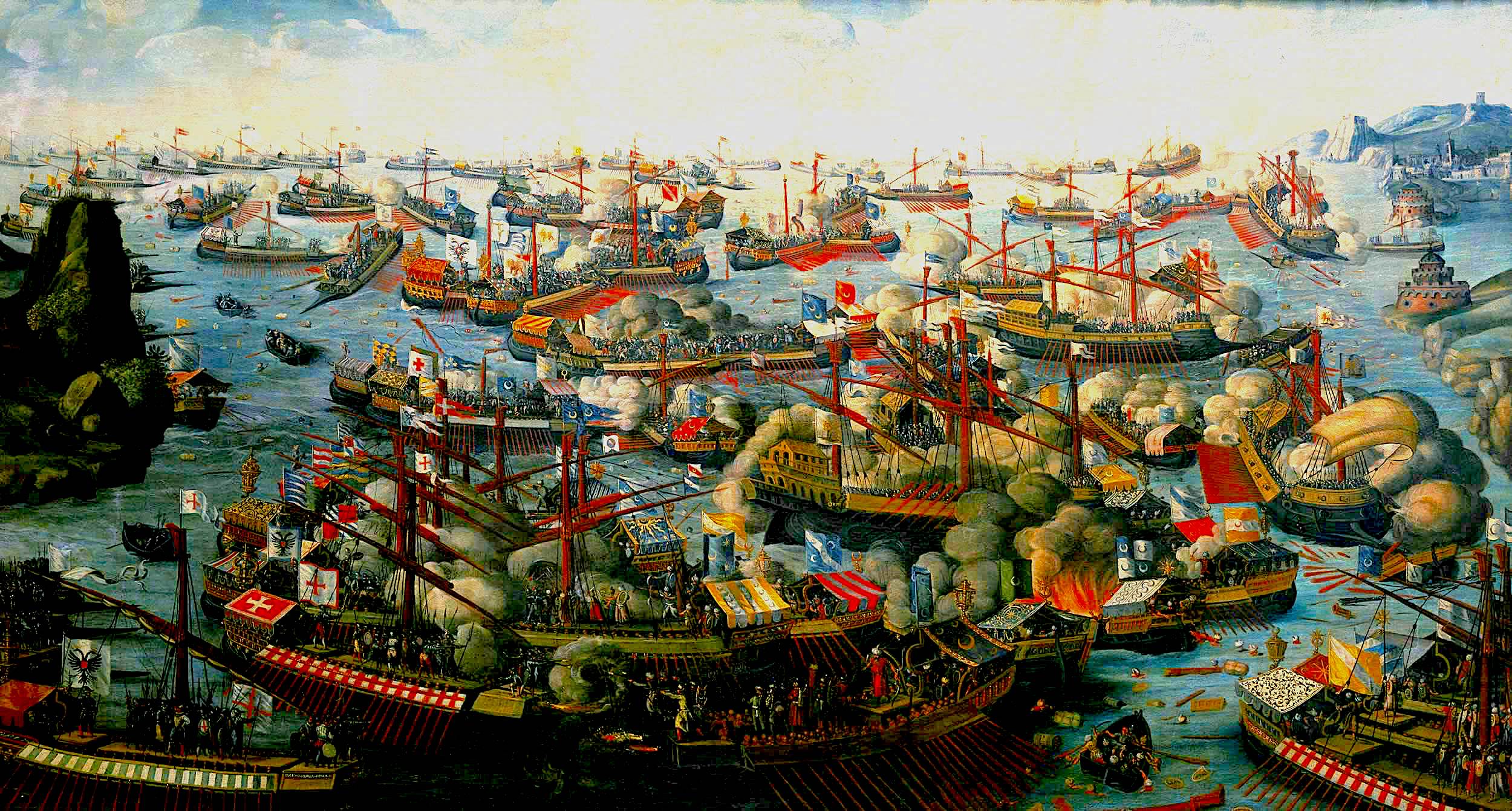
The Battle of Lepanto by anonymous. (National Maritime Museum of London, CC BY-SA 3.0, Wikimedia Commons)
In the 500 years since European exploration first brought the continents into continuous contact, the rise of every global hegemon has required one thing above all: dominance over Eurasia. Similarly, their decline has invariably been accompanied by a loss of control over that vast landmass. During the16th century, the Iberian powers, Portugal and Spain, waged a joint struggle to control Eurasia’s maritime commerce by battling the powerful Ottoman empire, whose leader was then the caliph of Islam. In 1509, off the coast of northeast India, skilled Portuguese gunners destroyed a Muslim fleet with lethal broadsides, establishing that country’s century-long dominance over the Indian Ocean. Meanwhile, the Spanish used the silver they had extracted from their new colonies in the Americas for a costly campaign to check Muslim expansion in the Mediterranean Sea. Its culmination: the destruction in 1571 of an Ottoman fleet of 278 ships at the epic Battle of Lepanto.
Next in line, Great Britain’s dominion over the oceans began with an historic naval triumph over a combined French-Spanish fleet off Spain’s Cape Trafalgar in 1805 and only ended when, in 1942, a British garrison of 80,000 men surrendered their seemingly impregnable naval bastion at Singapore to the Japanese — a defeat Winston Churchill called “the worst disaster and largest capitulation in British history.”
Like all past imperial hegemons, U.S. global power has similarly rested on geopolitical dominance over Eurasia, now home to 70 percent of the world’s population and productivity. After the Axis alliance of Germany, Italy and Japan failed to conquer that vast land mass, the Allied victory in World War II allowed Washington, as historian John Darwin put it, to build its “colossal imperium… on an unprecedented scale,” becoming the first power in history to control the strategic axial points “at both ends of Eurasia.”
In the early 1950s, Joseph Stalin and Mao Zedong forged a Sino-Soviet alliance that threatened to dominate the continent. Washington, however, countered with a deft geopolitical gambit that, for the next 40 years, succeeded in “containing” those two powers behind an “Iron Curtain” stretching 5,000 miles across the vast Eurasian land mass.
As a critical first step, the U.S. formed the NATO alliance in 1949, establishing major military installations in Germany and naval bases in Italy to ensure control of the western side of Eurasia. After its defeat of Japan, as the new overlord of the world’s largest ocean, the Pacific, Washington dictated the terms of four key mutual-defense pacts in the region with Japan, South Korea, the Philippines, and Australia and so acquired a vast range of military bases along the Pacific littoral that would secure the eastern end of Eurasia. To tie the two axial ends of that vast land mass into a strategic perimeter, Washington ringed the continent’s southern rim with successive chains of steel, including three navy fleets, hundreds of combat aircraft, and most recently, a string of 60 drone bases stretching from Sicily to the Pacific island of Guam.
With the communist bloc bottled up behind the Iron Curtain, Washington then sat back and waited for its Cold War enemies to self-destruct — which they did. First, the Sino-Soviet split in the 1960s shattered their hold on the Eurasian heartland. Then, the disastrous Soviet intervention in Afghanistan in the 1980s ravaged the Red Army and precipitated the break-up of the Soviet Union.
After those oh-so-strategic initial steps to capture the axial ends of Eurasia, however, Washington itself essentially stumbled through much of the rest of the Cold War with blunders like the Bay of Pigs catastrophe in Cuba and the disastrous Vietnam War in Southeast Asia. Nonetheless, by the Cold War’s end in 1991, the U.S. military had become a global behemoth with 800 overseas bases, an air force of 1,763 jet fighters, more than a thousand ballistic missiles, and a navy of nearly 600 ships, including 15 nuclear carrier battle groups — all linked by the world’s only global system of communications satellites. For the next 20 years, Washington would enjoy what Trump-era Defense Secretary James Mattis called “uncontested or dominant superiority in every operating domain. We could generally deploy our forces when we wanted, assemble them where we wanted, operate how we wanted.”
The Three Pillars of US Global Power
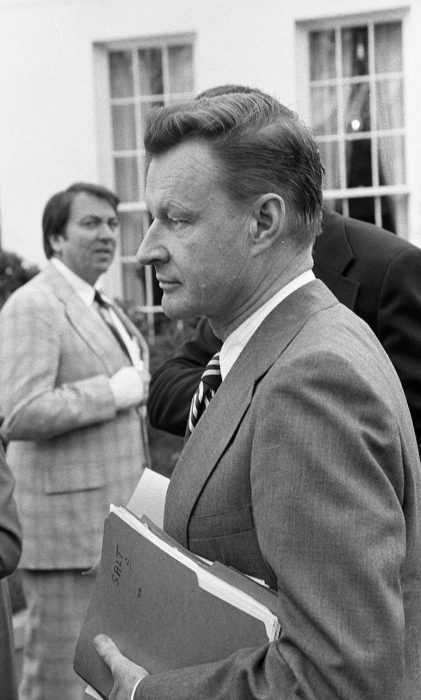
Zbigniew Brzezinski at a meeting with congressional leaders in 1977. (Library of Congress)
In the late 1990s, at the absolute apex of U.S. global hegemony, President Jimmy Carter’s National Security Advisor Zbigniew Brzezinski, far more astute as an armchair analyst than an actual practitioner of geopolitics, issued a stern warning about the three pillars of power necessary to preserve Washington’s global control. First, the U.S. must avoid the loss of its strategic European “perch on the Western periphery” of Eurasia. Next, it must block the rise of “an assertive single entity” across the continent’s massive “middle space” of Central Asia. And finally, it must prevent “the expulsion of America from its offshore bases” along the Pacific littoral.
Drunk on the heady elixir of limitless global power following the implosion of the Soviet Union in 1991, Washington’s foreign-policy elites made increasingly dubious decisions that led to a rapid decline in their country’s dominance. In an act of supreme imperial hubris, born of the belief that they were triumphantly at the all-American “end of history,” Republican neoconservatives in President George W. Bush’s administration invaded and occupied first Afghanistan and then Iraq, convinced that they could remake the entire Greater Middle East, the cradle of Islamic civilization, in America’s secular, free-market image (with oil as their repayment).
After an expenditure of nearly $2 trillion on operations in Iraq alone and nearly 4,598 American military deaths, all Washington left behind was the rubble of ruined cities, more than 200,000 Iraqi dead, and a government in Baghdad beholden to Iran. The official U.S. Army history of that war concluded that “an emboldened and expansionist Iran appears to be the only victor.”
Meanwhile, China spent those same decades building industries that would make it the workshop of the world. In a major strategic miscalculation, Washington admitted Beijing to the World Trade Organization (WTO) in 2001, bizarrely confident that a compliant China, home to nearly 20 percent of humanity and historically the world’s most powerful nation, would somehow join the global economy without changing the balance of power. “Across the ideological spectrum,” as two former Obama administration officials later wrote, “we in the U.S. foreign policy community shared the underlying belief that U.S. power and hegemony could readily mold China to the United States’ liking.” A bit more bluntly, former national security adviser H.R. McMaster concluded that Washington had empowered “a nation whose leaders were determined not only to displace the United States in Asia, but also to promote a rival economic and governance model globally.”
During the 15 years after it joined the WTO, Beijing’s exports to the U.S. grew nearly fivefold to $462 billion while, by 2014, its foreign currency reserves surged from just $200 billion to an unprecedented $4 trillion, a vast treasure it used to launch its trillion-dollar “Belt and Road Initiative” (BRI), aimed at uniting Eurasia economically through newly built infrastructure. In the process, Beijing began a systematic demolition of Brzezinski’s three pillars of U.S. geopolitical power.
The First Pillar — Europe

Chinese leader Xi Jinping, left, and Polish President Andrzej Duda sign a declaration on strategic partnership in June 2016. (Andrzej Hrechorowicz, CC BY-SA 4.0, Wikimedia Commons)
Beijing has scored its most surprising success so far in Europe, long a key bastion of American global power. As part of a chain of 40 commercial ports it’s been building or rebuilding around Eurasia and Africa, Beijing has purchased major port facilities in Europe, including outright ownership of the Greek port of Piraeus and significant shares in those of Zeebrugge in Belgium, Rotterdam in the Netherlands, and Hamburg, Germany.
After a state visit from Chinese President Xi Jinping in 2019, Italy became the first G-7 member to officially join the BRI agreement, subsequently signing over a portion of its ports at Genoa and Trieste. Despite Washington’s strenuous objections, in 2020, the European Union and China also concluded a draft financial services agreement that, when finalized in 2023, will more fully integrate their banking systems.
While China is building ports, rails, roads, and powerplants across the continent, its Russian ally continues to dominate Europe’s energy market and is now just months away from opening its controversial Nord Stream 2 natural gas pipeline beneath the Baltic Sea, guaranteed to increase Moscow’s economic influence. As the massive pipeline project moved to completion last December, Russian President Putin intensified pressures on NATO with a roster of “extravagant” demands, including a formal guarantee that Ukraine not be admitted to the alliance, removal of all the military infrastructure installed in Eastern Europe since 1997, and a prohibition against future military activity in Central Asia.
In a power play not seen since Stalin and Mao joined forces in the 1950s, the alliance between Putin’s raw military force and Xi’s relentless economic pressure may indeed slowly be pulling Europe away from America. Complicating the U.S. position, Britain’s exit from the European Union cost Washington its most forceful advocate inside Brussels’ labyrinthine corridors of power.
And as Brussels and Washington grow apart, Beijing and Moscow only come closer. Through joint energy ventures, military maneuvers, and periodic summits, Putin and Xi are reprising the Stalin-Mao alliance, a strategic partnership at the heart of Eurasia that could, in the end, break Washington’s steel chains that have long stretched from Eastern Europe to the Pacific.
The Second Pillar — Central Asia
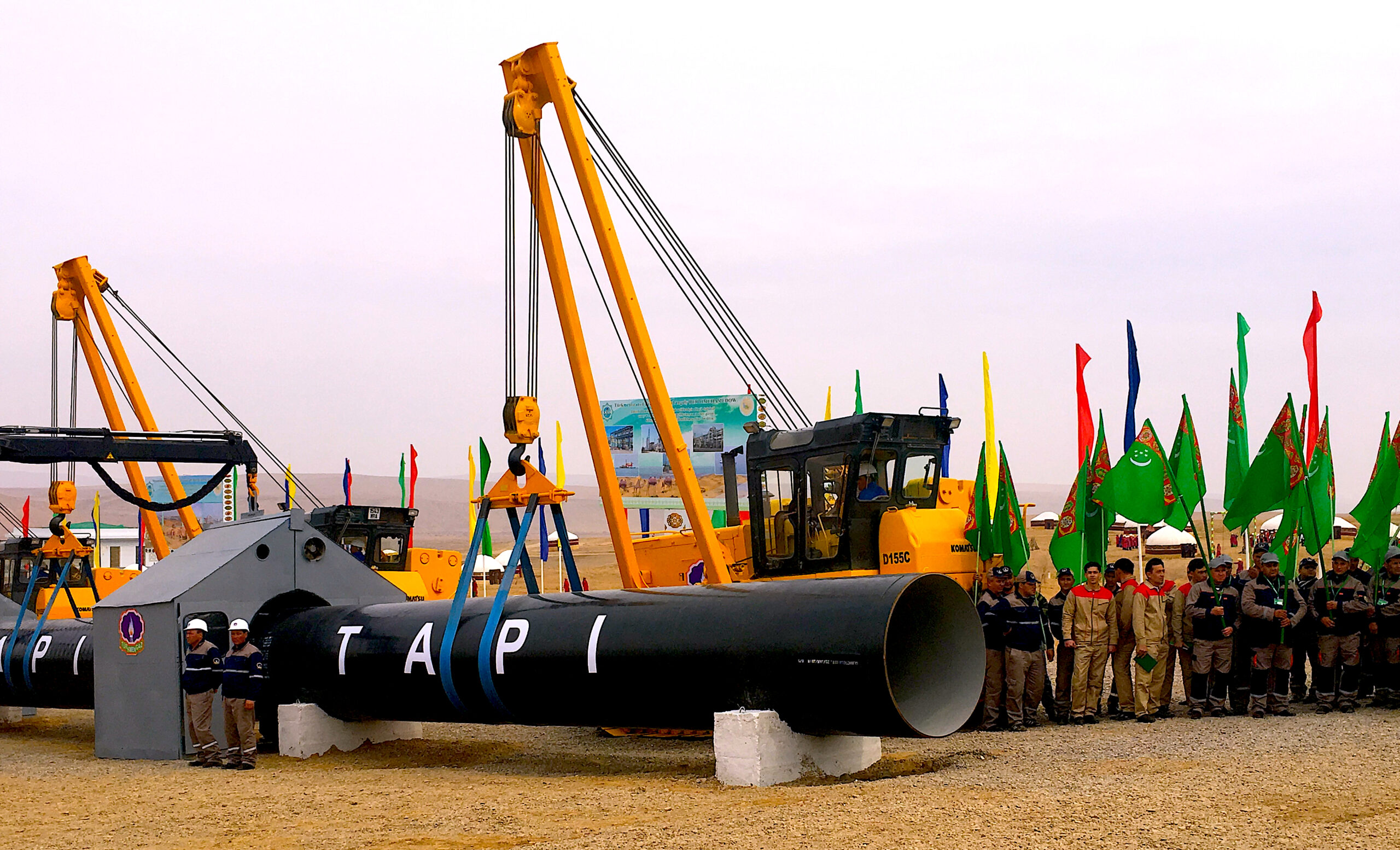
Ceremony on completion of the Turkmen section of the Turkmenistan-Afghanistan-Pakistan-India natural gas pipeline in 2018. (Allan Mustard, CC BY-SA 4.0, Wikimedia Commons)
Under its bold BRI scheme to fuse Europe and Asia into a unitary Eurasian economic bloc, Beijing has crisscrossed Central Asia with a steel-ribbed cat’s cradle of railroads and oil pipelines, effectively toppling Brzezinski’s second pillar of geopolitical power — that the U.S. must block the rise of “an assertive single entity” in the continent’s vast “middle space.” When President Xi first announced the Belt and Road Initiative at Kazakhstan’s Nazarbayev University in September 2013, he spoke expansively about “connecting the Pacific and the Baltic Sea,” while building “the biggest market in the world with unparalleled potential.”
In the decade since, Beijing has put in place a bold design for transcending the vast distances that historically separated Asia and Europe. Starting in 2008, the China National Petroleum Corporation collaborated with Turkmenistan, Kazakhstan, and Uzbekistan to launch a Central Asia-China gas pipeline that will eventually extend more than 4,000 miles. By 2025, in fact, there should be an integrated inland energy network, including Russia’s extensive grid of gas pipelines, reaching 6,000 miles from the Baltic to the Pacific.
The only real barrier to China’s bid to capture Eurasia’s vast “middle space” was the now-ended U.S. occupation of Afghanistan. To join Central Asia’s gas fields to the energy-hungry markets of South Asia, the TAPI (Turkmenistan-Afghanistan-Pakistan-India) pipeline was announced in 2018, but progress though the critical Afghan sector was slowed by the war there. In the months before it captured Kabul, however, Taliban diplomats turned up in Turkmenistan and China to offer assurances about the project’s future. Since then, the scheme has been revived, opening the way for Chinese investment that could complete its capture of Central Asia.
The Third Pillar — the Pacific Littoral
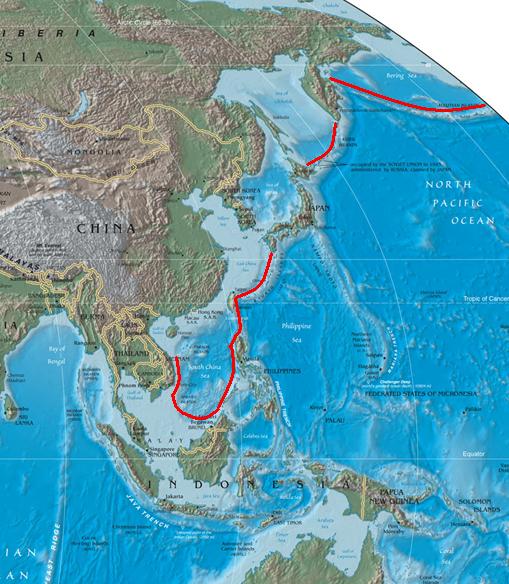
The “First Island Chain” perimeter marked in red. (Suid-Afrikaanse, CC BY-SA 3.0, Wikimedia Commons)
The most volatile flashpoint In Beijing’s grand strategy for breaking Washington’s geopolitical grip over Eurasia lies in the contested waters between China’s coast and the Pacific littoral, which the Chinese call “the first island chain.” By building a half-dozen island bases of its own in the South China Sea since 2014, swarming Taiwan and the East China Sea with repeated fighter plane forays, and staging joint maneuvers with Russia’s navy, Beijing has been conducting a relentless campaign to begin what Brzezinski called “the expulsion of America from its offshore bases” along that Pacific littoral.
As China’s economy grows larger and its naval forces do, too, the end of Washington’s decades-long dominion over that vast ocean expanse may be just over the horizon. For one thing, China may at some point achieve supremacy in certain critical military technologies, including super-secure “quantum entanglement” satellite communications and hypersonic missiles. Last October, the chair of the U.S. Joint Chiefs, General Mark Milley, called China’s recent launch of a hypersonic missile “very close” to “a Sputnik moment.” While U.S. tests of such weapons, which can fly faster than 4,000 m.p.h., have repeatedly failed, China successfully orbited a prototype whose speed and stealth trajectory suddenly make U.S. aircraft carriers significantly more difficult to defend.
But China’s clear advantage in any struggle over that first Pacific island chain is simply distance. A battle fleet of two U.S. supercarriers operating 5,000 miles from Pearl Harbor could deploy, at best, 150 jet fighters. In any conflict within 200 miles of China’s coast, Beijing could use up to 2,200 combat aircraft as well as DF-21D “carrier-killer” missiles whose 900-mile range makes them, according to U.S. Navy sources, “a severe threat to the operations of U.S. and allied navies in the western Pacific.”
The tyranny of distance, in other words, means that the U.S. loss of that first island chain, along with its axial anchor on Eurasia’s Pacific littoral, should only be a matter of time.
In the years to come, as more such incidents erupt around Eurasia’s ring of fire, readers can insert them into their own geopolitical model — a useful, even essential, means for understanding a fast-changing world. And as you do that, just remember that history has never ended, while the U.S. position in it is being remade before our eyes.
Alfred W. McCoy, a TomDispatch regular, is the Harrington professor of history at the University of Wisconsin-Madison. He is the author most recently of In the Shadows of the American Century: The Rise and Decline of U.S. Global Power (Dispatch Books). His latest book (to be published in October by Dispatch Books) is To Govern the Globe: World Orders and Catastrophic Change.
This article is from TomDispatch.com.
The views expressed are solely those of the author and may or may not reflect those of Consortium News.

Imagine a world free of this wasteful competition to dominate others. Our assault on nature is reaching a point for its response that will make life unsustainable. At some point, nuclear weapons will be used. Extinction is forever!
I saw an. article today ,( january 22,afternoon of west coast of USA,) which has disappeared. The photo with it shows a man in uniform of I believe navy. US or British? He is saying maybe Putin is right (in the matter of Ukraine and Russia), I can’t remember the words but the fact the article has been disappeared is very ominous in my opinion. Can someone enlighten me as to how to find this article. ? or summarize it if you can.
It is very likely the chief of the German Navy who resigned, saying Russia deserved respect and not to be threatened. hXXps://www.theguardian.com/world/2022/jan/23/german-navy-chief-quits-after-saying-putin-deserves-respect-over-ukraine
Thank you very much for directing me to the article that mentioned the chief of the German Navy saying Russia deserved respect. What an under-reported event, and they tried to make him recant. – BUT he has already said it. Here is a crack in the wall of propaganda that must be watched.
It is a nice to read an analysis of a historian. The story of the three pillars doesn’t have one of more reasons why it failed. It failed, that’s all according to McCoy. Why did England fail, or the Netherlands or the Italian States and now the US?
If you cannot tell the deeper reasons, it is just a story about foolish US people. They didn’t understand what is important.
Good luck with your next book or articles
Robert
Robert: ” . . If you cannot tell the deeper reasons, it is just a story about foolish US people. They didn’t understand what is important.”
I firmly believe that the author did a great job of doing just that. I would be very interested in hearing more of your view on this piece.
For starters US leader ship has had some very poor showings since Nov. 22, 1963.
You said it here, this is a story about foolish US people, most explicitly U.S. leaders, too many of whom grew up believing their own press releases. They were after all “exceptional”.
LBJ was no statesman, better at blackmail than most maybe, I dunno. We haven’t had great leadership since he took office. What we got was rule by the Deep State and when 43 lied to go to war I thought we had hit bottom with respect to leadership. The Village Idiot from Crawford Texas got elected and America paid the price him and his daddy set us up to pay.
Then what, one too many Clinton’s in the mix and the village idiot from NYC got elected (?).
43 spent national treasure on a war that was uncalled for and burnt through money like a drunken naval Aviator.
The cost for that mistake led the US into big money trouble and the village idiot form NYC left us with few to none friends overseas.
Rather than be concerned about Mr. McCoy’s future you may want to focus on your own.
On the other hand this is simply my opinion.
Responding to first (Wolfgang Geist’s) comment–Just because the elites playing geopolitical chess games are few (1%) and old and the 99% aren’t interested doesn’t mean they can’t destroy us all by design/accident. So we need to be concerned enough to try to understand. Moreover, by the time any young people who successfully pursue careers in whatever branch of the elite power structure actually become the decision-makers, they too will be “old” and will have absorbed the values/perspectives essential to maintaining the system
Someone once said: “In my 20’s I critiqued the System and wanted to abolish (much of) it; in my 30’s I tried to work for change within it; by the time I was 40, I WAS the System!”
Time to try cooperation.
We have known about the aim of dominance in Eurasia at least since Mackinder and his “world island”, and even more recently from Zbigniew Brzezinski with his book “The Grand Chessboard”. But what the United States does not realize is that it is not up to the US to dictate to Eurasia. The US Empire is an empire in decline, rotten as the wood of long-buried ships of exploration and conquest.
The problem is that the world is run by old people, The author of this article is one of them. They see the world from a narrow minding lens where some dumb ass elites make decisions and divide the world in us against them. These old farts don’t realize that 99% of the world population is not interested in their silly chess games and would like to live in peace, no empire needed. Hopefully they all will die soon and the younger generation will burn their books and stupid ideologies.
Your comment attributing the decline of empire to “old people” is a mistaken diversion. The ruling elites are the enemy of all humanity and capitalism is the cancerous excrescence of the ruling class. I am 73 years old and have been opposed to western imperialism since I was a teenager. Look more closely at those who support capitalism and you will find that it is not only people over the age of 60 but many young people in the “millennial” grouping who have completely swallowed the dictates of capitalism and still vote for one or the other of the two imperialist parties. Go read a few books, why don’t you.
Even tho’ I’m 72, I agree with a lot of what you said. There’s just two problems with it. One, it fails to recognize that these “elites” to which you refer are essentially just power hungry megalomaniacs. These evil people are everywhere and they all need to be returned for regrooving. These people are like shark’s teeth – on a conveyor belt where the oldest fall off but are replaced by other, equally evil, power hungry megalomaniacs. Two, you don’t burn books. That way leads to madness. Burning stupid ideologies is a good idea but, frankly, I’ve never run into an ideology that I didn’t think was stupid.
The only way we can stay ahead of China is to out race them economically. The only way we can do that is grow the middle class. The hyperwealthy are doing the opposite of this even now which is starting to compost the economy. All I can do right now is shake my head. They have literally sold the rope to hang all of us together.
You just brought home the missing angle in McCoy’s otherwise quite well thought out and wide-ranging if yet incomprehensive article. Kudos to you for spelling out the demolition of the American middle class at the expense of the unbridled rise of the hyper-rich and pinning it as a if not THE principal cause of the imminent US decline !
China is already ahead of the United States. The Chinese have dealt correctly with the pandemic. They have developed advanced technology that the U.S. wants to deny exists. In the end, nationalism is a fetter on the development of society.
It’s much easier to climb up a ladder than to climb down. The west climbed up; now it is time to climb down (without destroying the ladder, hopefully).
Of course the empires of tyrant demagogues have always ultimately decayed, over-extended, and declined.
A more rational hybrid economy and government like China, in a balance of superpowers, may last longer.
But the US is an amoral culture with an unregulated market economy that teaches and elevates its worst scammers.
It cannot be reformed because the tools of democracy, all federal branches and mass media, are fully corrupted.
It cannot be reformed by internal revolt because the technology of surveillance now precludes rebellion.
It is not a model for any ideal, not a trustworthy ally, not an economic powerhouse: it is a troublemaker.
It is doomed to descend into a one-party totalitarian state with ever less pretense of its long-gone democracy.
Great comment.
Capitalism cannot be reformed. Its entire foundation is the profit system, which is inimical to human life. It has outlived what usefulness it had at its beginning and should have been left behind a century ago. Because it has been allowed to continue to its ultimate extreme, we now see that it is like metastasizing cancer and is eating the planet. It must go.
Looking at the impact of the U.S. worldwide, we’re a source of war, starvation, suffering and death. We’re an evil empire. Will China be worse? That remains to be seen.
M. McCoy has summarized very well the “struggle” for dominance as the US elites see it. But why make it always look like a struggle for supremacy and instead dedicate energy to work out a new international order based on common institutions? Isn’t it what Russia, China and many other countries are aiming at? The US elites just show a lack of boldness and vision and as a result are driven by their fear of loosing. The agressiveness the US shows by imposing trade sanctions and economic threats in turn makes them look very threatening to other nations.
May be that’s because the “west” operates under a zero sum game principle, while the “east” operates under a win-win proposition? An example of the former is (neo) colonialism, while an example of the latter is BRI.
In the long run, win-win ought to win. In historic perspective, 500 years (of western dominance) is a short interval of time.
To top it off, the western culture prefers short term gain (supposedly because “in the long run we’ll all be dead”). It also encourages individual profit and betterment above collective interest. In contrast, eastern cultures value patience and a long perspective. They are also more likely to accept some individual sacrifices (now) for the betterment of the collective (in the future).
Spot on, Mr. Mulcahy! And so concisely stated.